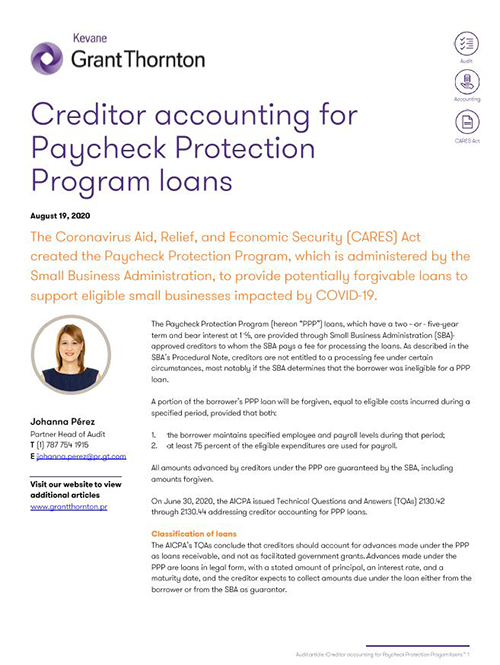-
Financial statements audits
Financial statement audits
-
Compliance audits
Compliance audits
-
Compilations and reviews
Compilations and audit
-
Agreed-upon procedures
Agreed-upon procedures
-
Corporate and business tax
Our trusted teams can prepare corporate tax files and ruling requests, support you with deferrals, accounting procedures and legitimate tax benefits.
-
International tax
Our teams have in-depth knowledge of the relationship between domestic and international tax laws.
-
Tax compliance
Business Tax
-
Individual taxes
Individual taxes
-
Estate and succession planning
Estate and succession planning
-
Global mobility services
Through our global organisation of member firms, we support both companies and individuals, providing insightful solutions to minimise the tax burden for both parties.
-
Sales and use tax and indirect taxes
SUT/ VAT & indirect taxes
-
Tax incentives program
Tax incentives program
-
Transfer Pricing Study
The laws surrounding transfer pricing are becoming ever more complex, as tax affairs of multinational companies are facing scrutiny from media, regulators and the public
-
Business consulting
Our business consulting services can help you improve your operational performance and productivity, adding value throughout your growth life cycle.
-
Forensic and investigative services
At Grant Thornton, we have a wealth of knowledge in forensic services and can support you with issues such as dispute resolution, fraud and insurance claims.
-
Fraud and investigations
The commercial landscape is changing fast. An ever more regulated environment means organizations today must adopt stringent governance and compliance processes. As business has become global, organizations need to adapt to deal with multi-jurisdictional investigations, litigation, and dispute resolution, address the threat of cyber-attack and at the same time protect the organization’s value.
-
Dispute resolutions
Our independent experts are experienced in advising on civil and criminal matters involving contract breaches, partnership disputes, auditor negligence, shareholder disputes and company valuations, disputes for corporates, the public sector and individuals. We act in all forms of dispute resolution, including litigation, arbitration, and mediation.
-
Business risk services
We can help you identify, understand and manage potential risks to safeguard your business and comply with regulatory requirements.
-
Internal audit
We work with our clients to assess their corporate level risk, identify areas of greatest risk and develop appropriate work plans and audit programs to mitigate these risks.
-
Service organization reports
As a service organization, you know how important it is to produce a report for your customers and their auditors that instills confidence and enhances their trust in your services. Grant Thornton Advisory professionals can help you determine which report(s) will satisfy your customers’ needs and provide relevant information to your customers and customers’ auditors that will be a business benefit to you.
-
Transaction advisory services
Transactions are significant events in the life of a business – a successful deal that can have a lasting impact on the future shape of the organizations involved. Because the stakes are high for both buyers and sellers, experience, determination and pragmatism are required to bring deals safely through to conclusion.
-
Mergers and acquisitions
Globalization and company growth ambitions are driving an increase in M&A activity worldwide as businesses look to establish a footprint in countries beyond their own. Even within their own regions, many businesses feel the pressure to acquire in order to establish a strategic presence in new markets, such as those being created by rapid technological innovation.
-
Valuations
We can support you throughout the transaction process – helping achieve the best possible outcome at the point of the transaction and in the longer term.
-
Recovery and reorganization
We provide a wide range of services to recovery and reorganisation professionals, companies and their stakeholders.
The Coronavirus Aid, Relief, and Economic Security (CARES) Act created the Paycheck Protection Program, which is administered by the Small Business Administration, to provide potentially forgivable loans to support eligible small businesses impacted by COVID-19.
The Paycheck Protection Program (hereon “PPP”) loans, which have a two – or - five-year term and bear interest at 1 %, are provided through Small Business Administration (SBA)-approved creditors to whom the SBA pays a fee for processing the loans. As described in the SBA’s Procedural Note, creditors are not entitled to a processing fee under certain circumstances, most notably if the SBA determines that the borrower was ineligible for a PPP loan.
A portion of the borrower’s PPP loan will be forgiven, equal to eligible costs incurred during a specified period, provided that both:
- the borrower maintains specified employee and payroll levels during that period;
- at least 75 percent of the eligible expenditures are used for payroll.
All amounts advanced by creditors under the PPP are guaranteed by the SBA, including amounts forgiven.
On June 30, 2020, the AICPA issued Technical Questions and Answers (TQAs) 2130.42 through 2130.44 addressing creditor accounting for PPP loans.
Classification of loans
The AICPA’s TQAs conclude that creditors should account for advances made under the PPP as loans receivable, and not as facilitated government grants. Advances made under the PPP are loans in legal form, with a stated amount of principal, an interest rate, and a maturity date, and the creditor expects to collect amounts due under the loan either from the borrower or from the SBA as guarantor.
Consideration of SBA guarantee
Under the guidance in ASC 326, Financial Instruments – Credit Losses, a creditor should include credit enhancements, such as guarantees, when estimating credit losses on a loan if the enhancement is “embedded” in the loan as opposed to being a “freestanding contract” that is distinct from the loan.
The SBA guarantee of a PPP loan is embedded in the loan and should be considered when estimating credit losses under ASC 326. The SBA guarantee of a PPP loan is considered embedded in the loan because it exists at the inception of the loan and throughout its life, is not entered into separately and apart from the loan, is not legally detachable, ceases to exist only if the creditor violates an obligation under the PPP guidelines, and, if the loan is transferred, the purchaser would benefit from the SBA guarantee as well.
For creditors that have not yet adopted the new credit losses guidance in ASC 326, SBA guarantees would also be considered embedded in the loan for purposes of determining the allowance for credit losses under ASC 450, Contingencies, or ASC 310, Receivables, as applicable.
Accounting for PPP fees
Creditors who process PPP loans earn a fee from the SBA upon funding the loan. The SBA pays the fee to the creditor on behalf of the borrower, and upon funding the loan, the creditor should account for the fee as a nonrefundable loan origination fee in accordance with ASC 310-20, Nonrefundable Fees and Other Costs. Accordingly, the fee should be offset against any deferred loan origination costs and recognized as an adjustment to yield over the life of the PPP loan.
The processing fee paid to the creditor may be subject to clawback by the SBA if any one of the following criteria applies:
The PPP loan is cancelled or voluntarily terminated and repaid after disbursement but before the borrower-certification safe harbor date.
- the PPP loan is cancelled, terminated, or repaid after disbursement (and after the borrower-certification safe harbor date) because the SBA reviewed the loan and determined that the borrower was ineligible for the PPP loan.
- the creditor has not fulfilled its obligations under the PPP regulations.
The clawback provisions do not make the fee refundable because they are designed to operate similarly to cancellation or penalty provisions in the event of violations of representations or warranties (or an obligation of the creditor). However, creditors should establish a loss contingency in accordance with the guidance in ASC 450 when it is probable that a loss has occurred, and the amount of loss is estimable.
Source:
Grant Thornton, On the Horizon July 9, 2020
We are committed to keeping you up to date of all developments that may affect the way you do business in Puerto Rico. Please contact us for further assistance in relation to this or any other matter.


